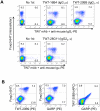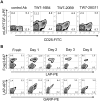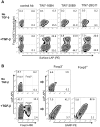TGF-β induces surface LAP expression on murine CD4 T cells independent of Foxp3 induction
- PMID: 21124798
- PMCID: PMC2991360
- DOI: 10.1371/journal.pone.0015523
TGF-β induces surface LAP expression on murine CD4 T cells independent of Foxp3 induction
Abstract
Background: It has been reported that human FOXP3(+) CD4 Tregs express GARP-anchored surface latency-associated peptide (LAP) after activation, based on the use of an anti-human LAP mAb. Murine CD4 Foxp3(+) Tregs have also been reported to express surface LAP, but these studies have been hampered by the lack of suitable anti-mouse LAP mAbs.
Methodology/principal findings: We generated anti-mouse LAP mAbs by immunizing TGF-β(-/-) animals with a mouse Tgfb1-transduced P3U1 cell line. Using these antibodies, we demonstrated that murine Foxp3(+) CD4 Tregs express LAP on their surface. In addition, retroviral transduction of Foxp3 into mouse CD4(+)CD25(-) T cells induced surface LAP expression. We then examined surface LAP expression after treating CD4(+)CD25(-) T cells with TGF-β and found that TGF-β induced surface LAP not only on T cells that became Foxp3(+) but also on T cells that remained Foxp3(-) after TGF-β treatment. GARP expression correlated with the surface LAP expression, suggesting that surface LAP is GARP-anchored also in murine T cells.
Conclusions/significance: Unlike human CD4 T cells, surface LAP expression on mouse CD4 T cells is controlled by Foxp3 and TGF-β. Our newly described anti-mouse LAP mAbs will provide a useful tool for the investigation and functional analysis of T cells that express LAP on their surface.
Conflict of interest statement
Figures




Similar articles
-
Overexpression of TGF-ß 1 gene induces cell surface localized glucose-regulated protein 78-associated latency-associated peptide/TGF-ß.J Immunol. 2010 Sep 15;185(6):3529-35. doi: 10.4049/jimmunol.0904121. Epub 2010 Aug 18. J Immunol. 2010. PMID: 20720212 Free PMC article.
-
CD4+CD25- T cells that express latency-associated peptide on the surface suppress CD4+CD45RBhigh-induced colitis by a TGF-beta-dependent mechanism.J Immunol. 2003 Mar 1;170(5):2516-22. doi: 10.4049/jimmunol.170.5.2516. J Immunol. 2003. PMID: 12594277
-
The Effects of Anti-LAP Monoclonal Antibody Down-regulation of CD4+LAP+ T Cells on Allogeneic Corneal Transplantation in Mice.Sci Rep. 2018 May 22;8(1):8021. doi: 10.1038/s41598-018-26235-5. Sci Rep. 2018. PMID: 29789580 Free PMC article.
-
Garp as a therapeutic target for modulation of T regulatory cell function.Expert Opin Ther Targets. 2017 Feb;21(2):191-200. doi: 10.1080/14728222.2017.1275568. Epub 2016 Dec 29. Expert Opin Ther Targets. 2017. PMID: 28001437 Review.
-
GARP: a surface molecule of regulatory T cells that is involved in the regulatory function and TGF-β releasing.Oncotarget. 2016 Jul 5;7(27):42826-42836. doi: 10.18632/oncotarget.8753. Oncotarget. 2016. PMID: 27095576 Free PMC article. Review.
Cited by
-
FVB/N mouse strain regulatory T cells differ in phenotype and function from the C57BL/6 and BALB/C strains.FASEB Bioadv. 2022 Jun 24;4(10):648-661. doi: 10.1096/fba.2021-00161. eCollection 2022 Oct. FASEB Bioadv. 2022. PMID: 36238362 Free PMC article.
-
Donor-specific CD8+ Foxp3+ T cells protect skin allografts and facilitate induction of conventional CD4+ Foxp3+ regulatory T cells.Am J Transplant. 2012 Sep;12(9):2335-47. doi: 10.1111/j.1600-6143.2012.04120.x. Epub 2012 Jun 8. Am J Transplant. 2012. PMID: 22681667 Free PMC article.
-
Anti-GARP Antibodies Inhibit Release of TGF-β by Regulatory T Cells via Different Modes of Action, but Do Not Influence Their Function In Vitro.Immunohorizons. 2023 Mar 1;7(3):200-212. doi: 10.4049/immunohorizons.2200072. Immunohorizons. 2023. PMID: 36928178 Free PMC article.
-
In vivo anti-LAP mAb enhances IL-17/IFN-γ responses and abrogates anti-CD3-induced oral tolerance.Int Immunol. 2015 Feb;27(2):73-82. doi: 10.1093/intimm/dxu083. Epub 2014 Sep 6. Int Immunol. 2015. PMID: 25194146 Free PMC article.
-
The effect of ionizing radiation on the homeostasis and functional integrity of murine splenic regulatory T cells.Inflamm Res. 2013 Feb;62(2):201-12. doi: 10.1007/s00011-012-0567-y. Epub 2012 Oct 19. Inflamm Res. 2013. PMID: 23080082
References
-
- Rubtsov YP, Rudensky AY. TGFβ signalling in control of T-cell-mediated self-reactivity. Nat Rev Immunol. 2007;7:443–453. - PubMed
-
- Miyazono K, Ichijo H, Heldin CH. Transforming growth factor-β: latent forms, binding proteins and receptors. Growth Factors. 1993;8:11–22. - PubMed
-
- Oida T, Zhang X, Goto M, Hachimura S, Totsuka M, et al. CD4+CD25− T cells that express latency-associated peptide on the surface suppress CD4+CD45RBhigh-induced colitis by a TGF-β-dependent mechanism. J Immunol. 2003;170:2516–2522. - PubMed
-
- Ochi H, Abraham M, Ishikawa H, Frenkel D, Yang K, et al. Oral CD3-specific antibody suppresses autoimmune encephalomyelitis by inducing CD4+CD25− LAP+ T cells. Nat Med. 2006;12:627–635. - PubMed
Publication types
MeSH terms
Substances
Grants and funding
LinkOut - more resources
Full Text Sources
Other Literature Sources
Molecular Biology Databases
Research Materials
Miscellaneous

